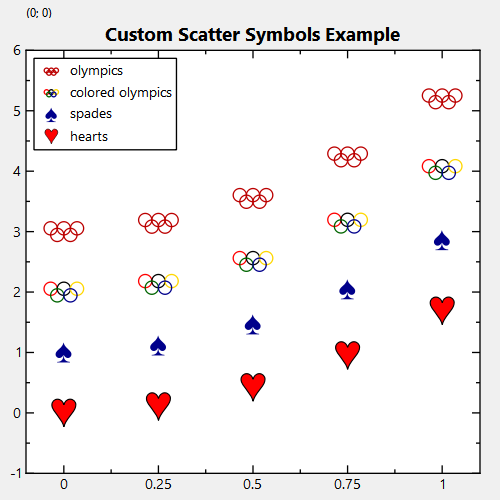mirror of
https://github.com/jkriege2/JKQtPlotter.git
synced 2025-01-26 23:49:10 +08:00
114 lines
5.5 KiB
Markdown
114 lines
5.5 KiB
Markdown
|
|
# Example (JKQTPlotter): Scatter-graph with custom symbols {#JKQTPlotterscatterCustomSymbol}
|
||
|
|
|
||
|
|
This project (see `./examples/scatter_customsymbol/`) demonstrates using JKQTPlotter to draw a scatter graph (JKQTPXYScatterGraph) with custom symbols.
|
||
|
|
|
||
|
|
The source code of the example can be found in [`jkqtplotter_scatter.cpp`](https://github.com/jkriege2/JKQtPlotter/tree/master/examples/scatter_customsymbol/scatter_customsymbol.cpp).
|
||
|
|
|
||
|
|
First we create a plotter window and get a pointer to the internal datastore (for convenience):
|
||
|
|
```.cpp
|
||
|
|
JKQTPlotter plot;
|
||
|
|
JKQTPDatastore* ds=plot.getDatastore();
|
||
|
|
```
|
||
|
|
Now we add several columns to the JKQTPDatastore and obtain back-inserter iterators for these:
|
||
|
|
```.cpp
|
||
|
|
size_t columnX=ds->addColumn("x");
|
||
|
|
auto colXInserter=ds->backInserter(columnX);
|
||
|
|
size_t columnY1=ds->addColumn("y1");
|
||
|
|
auto colY1Inserter=ds->backInserter(columnY1);
|
||
|
|
size_t columnY2=ds->addColumn("y2");
|
||
|
|
auto colY2Inserter=ds->backInserter(columnY2);
|
||
|
|
size_t columnY3=ds->addColumn("y3");
|
||
|
|
auto colY3Inserter=ds->backInserter(columnY3);
|
||
|
|
size_t columnY4=ds->addColumn("y4");
|
||
|
|
auto colY4Inserter=ds->backInserter(columnY4);
|
||
|
|
```
|
||
|
|
... and fill the columns with data
|
||
|
|
```.cpp
|
||
|
|
const int Ndata=5;
|
||
|
|
for (int i=0; i<Ndata; i++) {
|
||
|
|
// put data
|
||
|
|
const double x=double(i)/double(Ndata-1);
|
||
|
|
*(colXInserter++)=x;
|
||
|
|
*(colY1Inserter++)=3.0+pow(x*1.3, 2.0)*1.3;
|
||
|
|
*(colY2Inserter++)=2.0+pow(x*1.3, 2.0)*1.2;
|
||
|
|
*(colY3Inserter++)=1.0+pow(x*1.3, 2.0)*1.1;
|
||
|
|
*(colY4Inserter++)=pow(x*1.3, 2.0);
|
||
|
|
}
|
||
|
|
```
|
||
|
|
Now we create several graph objects of type JKQTPXYScatterGraph. Each one uses a different custom symbol style:
|
||
|
|
|
||
|
|
Graphs `graph3` and `graph4` use `JKQTPCharacterSymbol` and `JKQTPFilledCharacterSymbol` respectively to draw spades and hearts from the unicode characters `U+2660` and `U+2665` respectively. The two graphs differ in the coloring of the symbols. The `JKQTPCharacterSymbol` variant would use the color default (cycling) graph color, but here we overwrite this with `darkblue`. The `JKQTPFilledCharacterSymbol` variant uses red filled hearts with a thin black border.
|
||
|
|
```.cpp
|
||
|
|
JKQTPXYScatterGraph* graph3=new JKQTPXYScatterGraph(&plot);
|
||
|
|
graph3->setXColumn(columnX);
|
||
|
|
graph3->setYColumn(columnY3);
|
||
|
|
graph3->setSymbolType(JKQTPCharacterSymbol+QChar(0x2660).unicode());
|
||
|
|
graph3->setSymbolColor(QColor("darkblue"));
|
||
|
|
graph3->setSymbolSize(15);
|
||
|
|
graph3->setTitle(QObject::tr("spades"));
|
||
|
|
plot.addGraph(graph3);
|
||
|
|
|
||
|
|
JKQTPXYScatterGraph* graph4=new JKQTPXYScatterGraph(&plot);
|
||
|
|
graph4->setXColumn(columnX);
|
||
|
|
graph4->setYColumn(columnY4);
|
||
|
|
graph4->setSymbolType(JKQTPFilledCharacterSymbol+QChar(0x2665).unicode());
|
||
|
|
graph4->setSymbolSize(20);
|
||
|
|
graph4->setSymbolColor(QColor("black"));
|
||
|
|
graph4->setSymbolFillColor(QColor("red"));
|
||
|
|
graph4->setSymbolLineWidth(0.5);
|
||
|
|
graph4->setTitle(QObject::tr("hearts"));
|
||
|
|
plot.addGraph(graph4);
|
||
|
|
```
|
||
|
|
|
||
|
|
The more advanced graphs `graph1` and `graph2` use `JKQTPRegisterCustomGraphSymbol()` to register functors that draw user-specific symbols:
|
||
|
|
```.cpp
|
||
|
|
JKQTPCustomGraphSymbolFunctor f=[](QPainter& p) {
|
||
|
|
p.setBrush(Qt::NoBrush); // ensure that circles are not drawn filled
|
||
|
|
p.drawEllipse(QPointF(-0.33, -0.33/4.0), 0.33/2.0, 0.33/2.0);
|
||
|
|
p.drawEllipse(QPointF(0, -0.33/4.0), 0.33/2.0, 0.33/2.0);
|
||
|
|
p.drawEllipse(QPointF(0.33, -0.33/4.0), 0.33/2.0, 0.33/2.0);
|
||
|
|
p.drawEllipse(QPointF(-0.33/2.0, 0.33/4.0), 0.33/2.0, 0.33/2.0);
|
||
|
|
p.drawEllipse(QPointF(0.33/2.0, 0.33/4.0), 0.33/2.0, 0.33/2.0);
|
||
|
|
};
|
||
|
|
JKQTPGraphSymbols customsymbol_olympicrings=JKQTPRegisterCustomGraphSymbol(f);
|
||
|
|
JKQTPXYScatterGraph* graph1=new JKQTPXYScatterGraph(&plot);
|
||
|
|
graph1->setXColumn(columnX);
|
||
|
|
graph1->setYColumn(columnY1);
|
||
|
|
graph1->setSymbolType(customsymbol_olympicrings);
|
||
|
|
graph1->setSymbolSize(30);
|
||
|
|
graph1->setTitle(QObject::tr("olympics"));
|
||
|
|
plot.addGraph(graph1);
|
||
|
|
|
||
|
|
|
||
|
|
JKQTPGraphSymbols customsymbol_coloredolympicrings=JKQTPRegisterCustomGraphSymbol(
|
||
|
|
[](QPainter& p) {
|
||
|
|
p.setBrush(Qt::NoBrush); // ensure that circles are not drawn filled
|
||
|
|
const double w=p.pen().widthF();
|
||
|
|
p.setPen(QPen(QColor("red"), w));
|
||
|
|
p.drawEllipse(QPointF(-0.33, -0.33/4.0), 0.33/2.0, 0.33/2.0);
|
||
|
|
p.setPen(QPen(QColor("black"), w));
|
||
|
|
p.drawEllipse(QPointF(0, -0.33/4.0), 0.33/2.0, 0.33/2.0);
|
||
|
|
p.setPen(QPen(QColor("gold"), w));
|
||
|
|
p.drawEllipse(QPointF(0.33, -0.33/4.0), 0.33/2.0, 0.33/2.0);
|
||
|
|
p.setPen(QPen(QColor("darkgreen"), w));
|
||
|
|
p.drawEllipse(QPointF(-0.33/2.0, 0.33/4.0), 0.33/2.0, 0.33/2.0);
|
||
|
|
p.setPen(QPen(QColor("darkblue"), w));
|
||
|
|
p.drawEllipse(QPointF(0.33/2.0, 0.33/4.0), 0.33/2.0, 0.33/2.0);
|
||
|
|
});
|
||
|
|
JKQTPXYScatterGraph* graph2=new JKQTPXYScatterGraph(&plot);
|
||
|
|
graph2->setXColumn(columnX);
|
||
|
|
graph2->setYColumn(columnY2);
|
||
|
|
graph2->setSymbolType(customsymbol_coloredolympicrings);
|
||
|
|
graph2->setSymbolSize(30);
|
||
|
|
graph2->setTitle(QObject::tr("colored olympics"));
|
||
|
|
plot.addGraph(graph2);
|
||
|
|
```
|
||
|
|
Bothe variant show the olympic rings. `graph1` uses the (cycling) default graph color and `graph2` draws with user-defined colors.
|
||
|
|
|
||
|
|
The result looks like this:
|
||
|
|
|
||
|
|

|
||
|
|
|
||
|
|
|
||
|
|
|